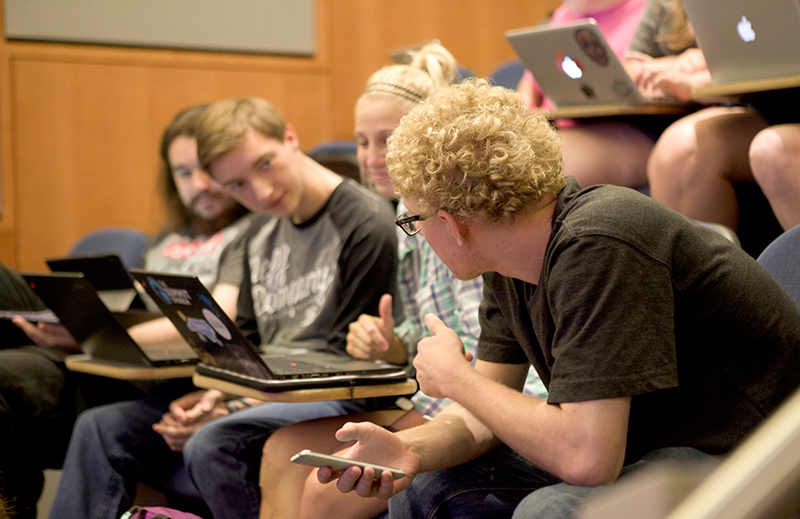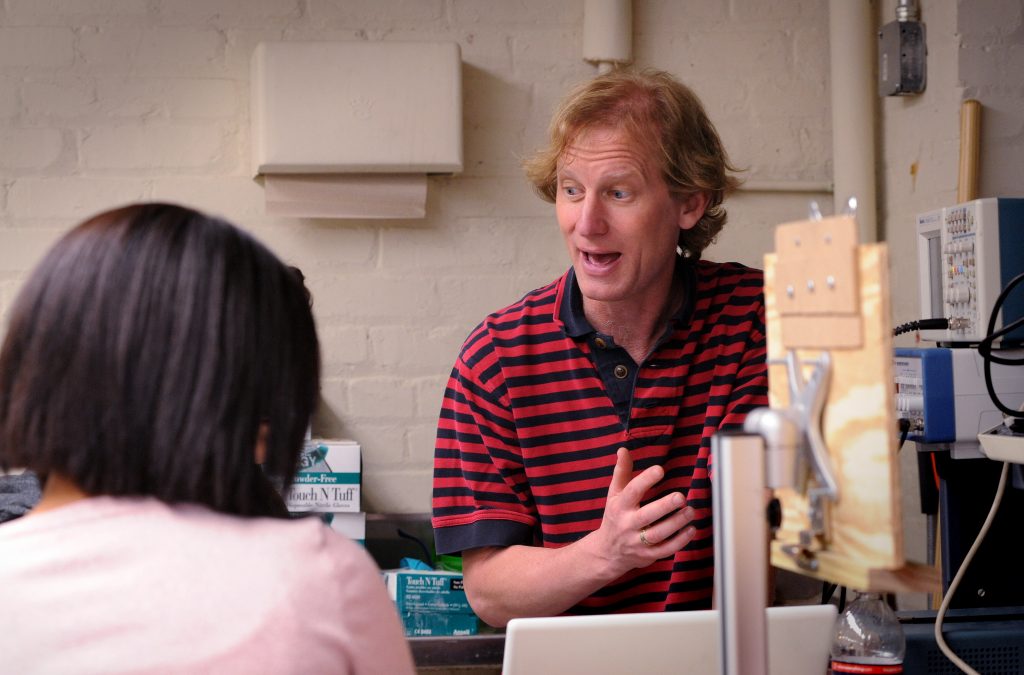
Innovation in the Field
The Flipped Classroom in a Large Lecture Course
Interview with Economics faculty Rita A. Balaban and Donna B. Gilleskie
Adapted from an article in the Sep 2016 edition of the Journal of Economic Education –
Describe the course at UNC (size, level, type of students who take it…)
Introduction to Economics (ECON 101) is a one-semester course that introduces students to microeconomics and macroeconomics. Most schools generally cover this content over two semesters, but because of resource constraints at UNC-CH we cover all of this content in one semester. Hence, we go at a very fast pace. A majority of the students are first-year students who are either taking it as a pre-requisite for their major (e.g. economics, business, public policy, public health) or taking it to fulfill a General Education requirement. With the exception of a few, small honors sections that we offer, the course generally has 400 students in each section.
Why did you switch from a traditional lecture format to the flipped classroom?
I (Rita Balaban) wanted the students to engage more in the material during class without sacrificing content. The flipped classroom allowed me to move the lecture outside of the classroom by producing videos of the lecture I traditionally would have provided in class for the students to watch before they came to class, so that during our class time the students could work in small groups solving problems and discussing the content. It just makes sense that if you want to learn a skill, you need to practice using it in various contexts. It’s much like practicing an instrument or playing a sport. You can watch videos, read books, listen to your coach, for example, on how to shoot off of the dribble, but you’ll never really learn how to score off of the dribble until you practice it. Similar to the coach who can catch and correct an athlete’s weaknesses by watching them practice, my teaching assistants and I spread ourselves across the room and work with our students as they are solving their problems. We identify problem areas and I use that feedback to determine whether we need to practice that skill more or if we can move onto a new one. Aside from personal interaction with the students, I also assess student understanding by peppering them with quiz questions based on the in-class problems.
What did you find?
With the assistance of my colleague, Donna Gilleskie, and a research assistant, Uyen Tran, and financial support from UNC’s Center for Faculty Excellence, we analyzed whether the flipped classroom improved student learning relative to a traditional classroom, i.e. one that delivers an in-class lecture. To do the analysis, we looked at common questions that were given on a comprehensive final exam for two large sections of ECON 101 that were taught by Dr. Balaban. One section was taught using the traditional lecture format during the Fall 2013 semester and the other was taught during the Fall 2014 semester using the flipped classroom approach. Given our large sample size and the quality of the data, we were able to do a very rigorous quantitative analysis and we found that the flipped classroom format positively impacts student grades. Furthermore, our work is unique to the economics education literature because we were able to estimate the effect of the flipped classroom on different levels of learning as defined by Bloom’s taxonomy. We found that the greatest gains from the flipped classroom are on the higher-order cognitive skills of application and analysis. Specifically, we found a 10-percentage point increase in performance in these cognitive areas.
In other words, you didn’t observe a big effect on lower level thinking like recalling facts, but you had large gains on what many instructors would call “critical thinking skills”? Why do you think that is the case?
Yes, that is correct. Our results indicate that the flipped classroom has the largest effect on critical thinking skills (comprehension, application, and analysis) and no marginal effect on things like recalling facts or restating a definition (knowledge). This was a really uplifting result because critical thinking skills are so difficult to teach, especially in a class of roughly 400 students! To think critically you have to really understand the content, not just memorize it. In my classroom, I use different types of problems to get the students engaged with the material and to evaluate their learning. The intention is to get them to learn – not memorize – the concepts so that they can use it in multiple ways. In a traditional, lecture-style class, we do not give students enough opportunities to work with the material because we are so focused on giving a lecture. Therefore, we ask students to do this outside of class, either on their own or with friends, but do they really do it effectively? In a lecture there is too much handholding. For instance, during a lecture we define a problem and proceed to walk the students through it. That stagnates critical thinking because the students are not challenged to think about the material and ponder alternative ways to solving the problem. Remarkably, we solve the problems for students during a lecture, but expect them to be able to solve them flawlessly on an exam. It doesn’t make sense. In a flipped classroom we present a low-stakes environment that gives the students a lot of opportunities to critically think about the material, solve problems, and receive immediate feedback. On reflection, it is not surprising that the flipped classroom develops the critical thinking skills of students significantly better than a traditional classroom.
Can you give me an example of a type of higher order or critical thinking skill question vs. a lower level recall type question in economics that most people would understand and see the difference between these levels of thinking?
An example of a low-level question would be, “What is the name of the interest rate that a bank pays when it borrows directly from the Fed?” A higher order question might ask, “Suppose the economy is growing at a rate higher than the Solow growth rate. To bring the economy back to full employment, what should the Fed do?” To answer this last question correctly, the student has to understand the terms, know what the Fed can do to slow down economic growth, and make some assumption about what caused the economy to grow so fast. Without understanding the cause, the proper prescription cannot be applied.
Did this only help the top student in the class?
Gratefully, no! We found substantial gains at every level of performance across the full distribution of student performance measured by quantiles. Although there is a little bit of variation in the size of the gains across performance levels for different types of questions, the overall finding is that people at different points of the performance distribution gained significantly under the flipped classroom format. So in other words, strong, moderate, and weak students, conditional on other observable characteristics, all benefited on average in the flipped classroom.
So you mean that in your study, C students gained critical thinking skills about equal to A and B students?
Actually, when we look only at application-type questions, the C and D students saw larger improvements in performance than the A students. However, I want to emphasize that our results indicate that all students benefit substantially in a flipped classroom.

 JOIN OUR MAILING LIST
JOIN OUR MAILING LIST

